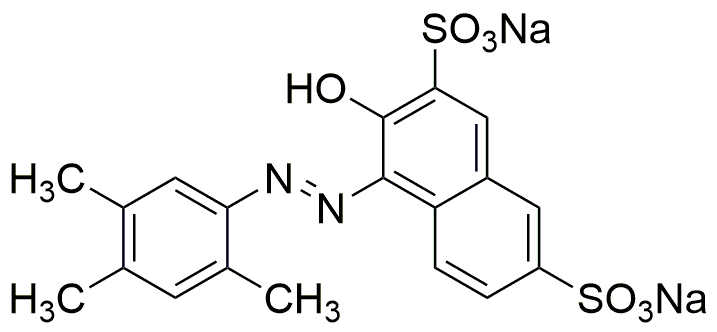Disodium 1-(dimethylphenylazo)-2-naphthol-3,6-disulfonate is widely utilized in research focused on:
- Analytical Chemistry: This compound serves as a chromogenic reagent in various analytical methods, allowing for the detection and quantification of metal ions in solution, which is crucial for environmental monitoring and quality control in manufacturing.
- Textile Industry: It is used as a dye in textile applications, providing vibrant colors and excellent lightfastness, which enhances the durability and appeal of fabrics.
- Biological Research: The compound acts as a pH indicator in biochemical assays, enabling researchers to monitor changes in acidity or alkalinity during experiments, which is essential for accurate data interpretation.
- Food Industry: It can be applied as a food colorant, offering a safe and effective way to enhance the visual appeal of various food products while complying with regulatory standards.
- Pharmaceuticals: The compound is utilized in the development of drug formulations, where it aids in the stabilization of active ingredients, improving the efficacy and shelf-life of medications.
General Information
Properties
Safety and Regulations
Applications
Disodium 1-(dimethylphenylazo)-2-naphthol-3,6-disulfonate is widely utilized in research focused on:
- Analytical Chemistry: This compound serves as a chromogenic reagent in various analytical methods, allowing for the detection and quantification of metal ions in solution, which is crucial for environmental monitoring and quality control in manufacturing.
- Textile Industry: It is used as a dye in textile applications, providing vibrant colors and excellent lightfastness, which enhances the durability and appeal of fabrics.
- Biological Research: The compound acts as a pH indicator in biochemical assays, enabling researchers to monitor changes in acidity or alkalinity during experiments, which is essential for accurate data interpretation.
- Food Industry: It can be applied as a food colorant, offering a safe and effective way to enhance the visual appeal of various food products while complying with regulatory standards.
- Pharmaceuticals: The compound is utilized in the development of drug formulations, where it aids in the stabilization of active ingredients, improving the efficacy and shelf-life of medications.
Documents
Safety Data Sheets (SDS)
The SDS provides comprehensive safety information on handling, storage, and disposal of the product.
Product Specification (PS)
The PS provides a comprehensive breakdown of the product’s properties, including chemical composition, physical state, purity, and storage requirements. It also details acceptable quality ranges and the product's intended applications.
Certificates of Analysis (COA)
Search for Certificates of Analysis (COA) by entering the products Lot Number. Lot and Batch Numbers can be found on a product’s label following the words ‘Lot’ or ‘Batch’.
*Catalog Number
*Lot Number
Certificates Of Origin (COO)
This COO confirms the country where the product was manufactured, and also details the materials and components used in it and whether it is derived from natural, synthetic, or other specific sources. This certificate may be required for customs, trade, and regulatory compliance.
*Catalog Number
*Lot Number
Safety Data Sheets (SDS)
The SDS provides comprehensive safety information on handling, storage, and disposal of the product.
DownloadProduct Specification (PS)
The PS provides a comprehensive breakdown of the product’s properties, including chemical composition, physical state, purity, and storage requirements. It also details acceptable quality ranges and the product's intended applications.
DownloadCertificates of Analysis (COA)
Search for Certificates of Analysis (COA) by entering the products Lot Number. Lot and Batch Numbers can be found on a product’s label following the words ‘Lot’ or ‘Batch’.
*Catalog Number
*Lot Number
Certificates Of Origin (COO)
This COO confirms the country where the product was manufactured, and also details the materials and components used in it and whether it is derived from natural, synthetic, or other specific sources. This certificate may be required for customs, trade, and regulatory compliance.


